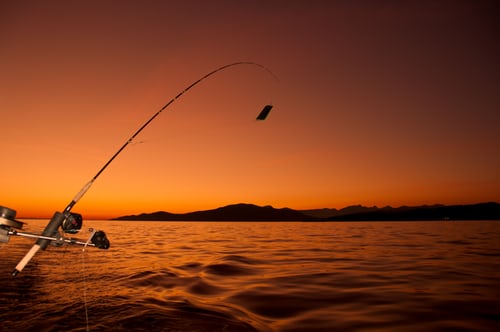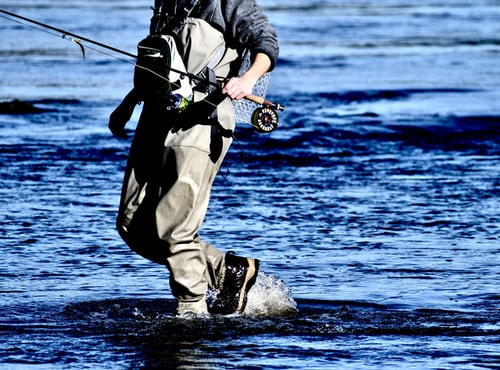Compared to freshwater fishing, saltwater fishing is an exciting experience due to deep-sea adventures and the opportunity to capture a big game. Saltwater fishing gears are typically designed robustly to resist salt corrosion. Do you know how to clean a fishing reel after saltwater use? Read on to find out more!
However, gears used in saltwater fishing should be properly maintained for durability. If the reel is not well washed, the reel’s inside and outside would usually be affected by the salt that shortens their lifetime.
Indeed, one of the toughest disappointments you can ever have when you’re fishing is that your reel doesn’t work when you’re fighting a big catch. The positive thing is that you can escape such disappointments by preserving your saltwater fishing gear and, in particular, your fishing gear properly. Then the reel is going to be accurate.
How To Clean A Fishing Reel After Saltwater Use

Many of the new saltwater fishing reels, rods, and lures are made of high-quality, non-corrosive materials – but that doesn’t mean anglers should miss maintenance. Below are recommended steps for anglers to follow before and after each saltwater fishing trip to keep reels, rods, and lures in tip-top condition.
It’s best to clean the reel immediately after a fishing adventure. You clean it right away because the salt residues will not harm any of the reel parts and that little or no salt will penetrate into the inside of the reel.
Worth noting is that while you may clean the reel’s exterior well after every fishing trip, some dirt, salt, and sand will still get inside the reel and need to be cleaned after a while. How much you need to clean the interior depends on how often you use the fishing reel.
To clean the inside of the reel, the reel must be disassembled. Often, if the reel is immersed in water, it would need to be thoroughly washed by disassembling all reel pieces.
A. Routine Washing After Fishing Day
As much as you’ll be so exhausted after a fishing trip, in order to be able to use your fishing reel in the future, you need to devote a few minutes to clean your fishing reel. Otherwise, the reel is going to be rough during your next fishing adventure to your disappointment. The good news is that it’s a pretty easy procedure that will save you a lot in the long run, so you don’t need to change your reel because you’re corroded by saltwater.
B. Wash Your Reel
Next, tighten the drags to prevent water and salt from entering the inside of the reel. Second, use a wet towel to clean the reel that removes any salt or grime from the reel. Clean the reel with warm and soapy water to remove salt, lubricating oil, and dirt. You should remove the spool to clean the bottom of the spool. Use a cotton tip applicator to get to the secret areas of the reel.
C. Clean Water Rinses The Reel
Now use water without undue pressure to clean the reel because excessive force pushes the water and any residual salt into the inside of the reel. The spray bottle would then work well.
D. Wipe The Reel
Now wash the reel with a wet microfiber piece of cloth or a piece of cloth that does not leave the reel’s fibers to clear any salt residues. Then use a dry piece of cloth to dry the reel and then let the air dry. Next, lubricate the reel with the oil that came with the reel or with any lubricating oil suggested by the manufacturer. Now use a protective coating to wipe the reel with care to avoid the fishing line and the reel handles part.
E. Clean The Inside Of The Fishing Reel
Once every six months to one year or even two years, your reel will have to be thoroughly washed. The method involves cleaning each part of the reel by first disassembling the reel. You should take this time to check each section and replace all worn parts when you reassemble the reel.
You’re going to extract any salt, dirt, and lubricating oil that’s trapped within the reel. It is strongly recommended that you grasp your reel’s parts by carefully reviewing the user manual for this process. Alternatively, you can opt to use a knowledgeable and trustworthy service center or store.
F. Require Cleaning Accessories
You need a small brush for cleaning the components to clean your reel effectively. You may use a small brush or an old toothbrush. Other cleaning products needed include a small screwdriver, a pair of tweezers, a toothpick, and a cleaning solution.
G. Disassembly Of The Reel And Cleaning Of Each Part
Use a small screwdriver to disassemble all parts of the reel, taking sure to mark each part in sequence. Be very careful, particularly with small parts like screws. Use a wet rag to remove any debris of salt and lubricating oil from each part.
Then soak the ingredients in warm water that has a cleaning agent for around 10 to 15 minutes. Warm water helps dissolve the salt and lubricating oil from the reel parts. It is strongly recommended that you use the cleaning solution recommended by the reel manufacturer.
Ensure that each surface of the reel part is thoroughly cleaned using a small brush. Second, rinse the reel in warm water before cleaning it with a piece of cloth of microfiber. Then the air will dry the reel components to ensure that all the pieces are fully dry.
H. Reassemble Your Reel
At last, reassemble the reel. Follow the sequence of how each part of the reel has been removed. Then lubricate the parts of the reel that need to be lubricated. Now hold the reel securely in a good storage container before your next fishing trip.
How To Clean A Fishing Reel After Saltwater Use: Don’t Do These

Don’t use salt water to rinse your fishing reel. Instead, use fresh water, as saltwater will eventually destroy your fishing rod. That’s why, when you go fishing for saltwater, make an effort to clean your fishing gear immediately after every fishing trip. Never target a spray nozzle or hose directly at the reel, as this will create a kind of high pressure that will drive sand, gravel, and salt into the drag and gear systems.
This is going to ruin your fishing reel. You can clean the fishing reel by using a mild freshwater rinse. Aim the reel down so that the water that carries salt, sand, and dirt goes down along the rod and down to the ground and not into the drag and gear systems. If the fishing reel is dry, you should clean it off with a lubricant before you store it.
Using things such as gasoline to try to remove grease and dirt from the fishing rod can damage the plastic. Instead, consider using biodegradable materials and a toothbrush to avoid damaging the fishing rod’s fiber and plastic parts. Don’t leave the drag button on when you clean the bottom of the spool.
Instead, remove the drag knob before continuing to grease the shaft and positioning the drag knob and spool. However, hold the drag button loose to avoid putting pressure off the drag washer while it is not in use. Make sure you place the sewing machine or high-grade reel oil on the handle knobs, the bras springs, the line rollers, and the folding handle, and then clean off the remaining oil.
More Information
We don’t expect everybody to be fishing every day, so there’s a big risk that your fishing gear will be stored and probably forgotten before your next fishing trip. Maintenance of the fishing reel is still part of the cleaning process. Make sure you keep greasing the gears and bearings gently on a regular basis. Don’t use too much fat, because sometimes other people tend to overdo it.
Often, consider reassembling the pieces correctly since there are a lot of parts. If you’re not sure what you’re doing, if you have any concerns about your fishing gear, whether it’s broken, or if you need any cleaning help, you can always go to your nearest fishing gear store for assistance.
How To Clean A Fishing Reel After Saltwater Use: Most Common Reel Performance Issues

Here are the most popular reel output issues and how to address them.
1. Line Twist
Line twist is the most common problem in spinning reels and can occur for various reasons, including over-the-counter use. Some lures, such as in-line spinners, twist the line if the lure’s shaft is not straight. The line twist happens when the lure, rather than the blade, flip in the water as you roll in and throw.
Line twisting often happens when a new line is spooled by hand, which may result in irregular and sometimes loose line distribution. Line Twist is a common problem for closed-face spinster reels that are tangling under the cap.
If you have a line twist, the only solution is to strip off the old line and apply a new line with a professional machine for a close and even wind.
2. Spring Dance
One of the greatest mechanical failures in spinning reels is the internal bail springs. If the return spring fails to turn the bail back open, the bail springs will likely be harmed. This can happen as a result of effects or long-term use.
It is important to remember that the bail mechanism’s problem may be the bail wire, not the bail spring, so it is important to first check the external bending of the exposed wire before disassembling the reel to repair the spring.
The springs are easy and inexpensive to repair. If you have an older model reel, new parts may be difficult to locate, but a reel repair specialist can typically suggest a suitable replacement.
3. Braided Line Slippage
Braided lines are very traditional and are becoming more common. Although incredibly durable, braided lines do not have a stretch that can lead to tangles as the line slips around the spool. New users will not realize that the slick line does not stick to the spool easily. The braided line needs some anchoring for optimum efficiency.
To act as a grip for the braided line, add the backrest directly to the reel. You may use a few monofilament lines wraps on the spool base before you cover the woven line or use the electrical tape. Both options provide fast backup to avoid line slippage.
4. Line Size
Many anglers actually use the wrong line size for their reel. It is necessary to obey the advice of the manufacturer. Using a line that does not suit the reel will impede performance and cause tangle and casting problems. Most often, anglers use a line that is too heavy for a reel.
Use the recommended line of the manufacturer for your particular reel. They are usually written directly on the reel spool or included in the product information.
5. The Wind Level
The exposed level wind on baitcaster rollers makes it one of the most common maintenance issues. The level wind is used for flushing the line equally when you roll. The level wind, powered by a worm gear assembly, is constantly exposed to water, gravel, grit, and sand, obstructing parts and preventing movement. This issue is typical to anglers who fish from the bank and sometimes place the rod on the deck.
The wind level is quickly replaced if it is broken, but also just needs to be washed. After each use, a wipe-down is recommended. It is also recommended that, sometimes, the reel be fully disassembled to clean and lube the worm gear, which keeps the mechanics of the part working properly. You can do this on your own with simple reels, but complex reels can require professional cleaning.
6. Harm To Paw
Any amount of dirt in the worm gear assembly will prevent the paw from moving properly against the tight track, causing the gear to lock up. This can trigger a stripping of the gear or an uneven ride of the paw, which sticks to one side of the gear.
The effect is a line stack on one side of the spool. If this occurs, a number of parts may always need to be replaced. Owing to the fragile existence of the paw, it is usually not fixed. General wear on the paw can be avoided with daily cleaning and maintenance.
7. Old Bearings
Pure and easy, bearings get worn out over time. Dirt and grit are the most common cause of damage to bearings, particularly if the reel has been submerged. Low-performance bearings can have an effect on the casting and reeling of your line. You may want to change to better performance, longer-lasting style when replacing bearings.
Bearings may be removed and soaked in a metal cleaner to degrease and remove debris but are cheap and typically easier to replace.
8. Over Lubrication
The lubricating of the reel is almost as bad as not lubricating it at all. Too much lubrication or incorrect lubrication closes the bearings and decreases the overall efficiency of your reel. The effect is too much drag on the line, slower functionality, and more pressure needed to turn the handle.
It’s almost impossible to clean the bearings properly from over-lubrication, so replacement is your best choice. This dilemma can be easily avoided. Use just a drop of oil or grease on the bearing. Keep in mind that the proper lubricant for steel and ceramic bearings is not the same.
How To Clean A Fishing Reel After Saltwater Use:Cleaning Tips

It may be hard to believe, but there are still people out there who regularly wash their rods and rollers with a harsh spray from the end of their garden hose. We cringe every time I see someone bow down and blow their expensive equipment like this.
Modern reels are engineering wonders. They are able to endure a generous amount of violence and keep ticking like a fine watch. But, after a day out on the water, they do need some attention — especially saltwater.
1. Gently Spritz
At the end of the day, line up the equipment and gently foam it with water. Salt accumulations can quickly dissolve and run off the reel without having to resort to extreme spraying. Harsh water baths cause salt and water to be pushed inside the reel where it stays, speeding up the malfunction.
2. Wipe Off
After a gentle wash, clean your reels with a dry paper towel or cotton cloth. Avoid the desire to use compressed air to blow them free. This, too, drives the water through the internal mechanisms of the reels.
3. Loosen Up
Before you put away your reels, I suggest loosening the drag. This relieves the pressure on the drag washers, springs, and disks. However, bear in mind that you need to re-tighten your drag before making your first cast on your next ride.
4. Lubricate
A thin lubricant coating on the reels’ surface can prevent corrosion and keep the reel components running smoothly. Stop spraying the lubricant inside your reel. Some oil-based lubricants break down greases, accelerating the demise of the inner sections of the reel.
Final Words
The well-maintained fishing reel runs smoothly and lasts a long time. As much as the saltwater reels are made of corrosion-resistant anti-rust materials, the reel can still be corroded by saltwater if it is not well maintained. Also, make sure you maintain your other fishing gear on a regular basis to keep it in good working order, including a fishing rod and fishing lures.


